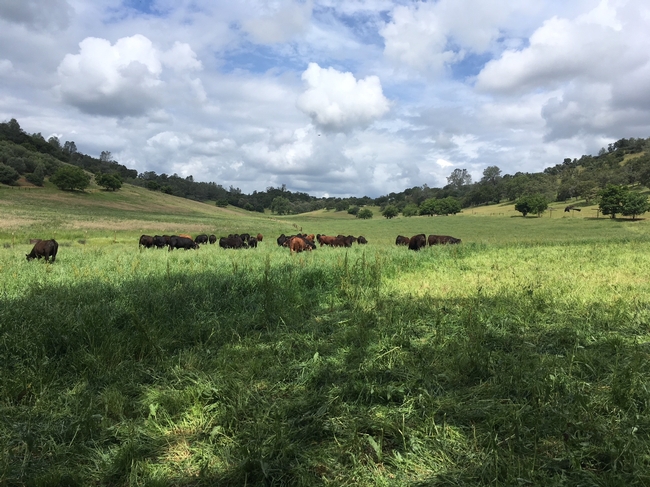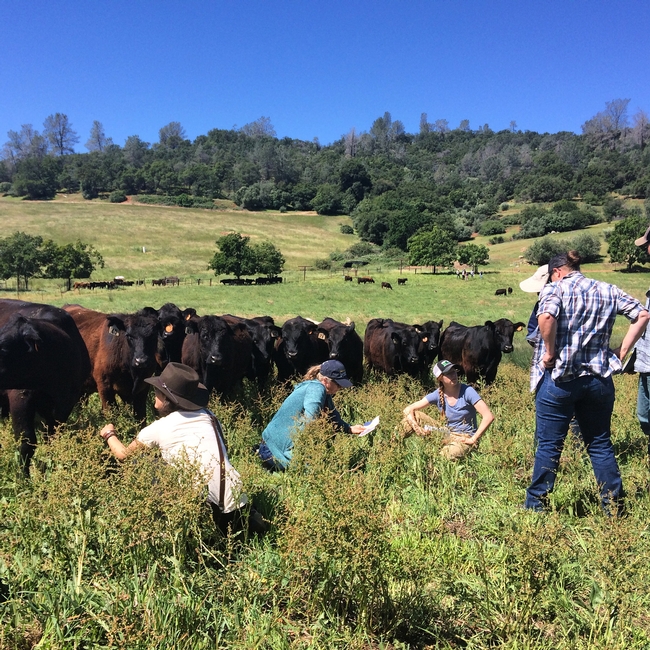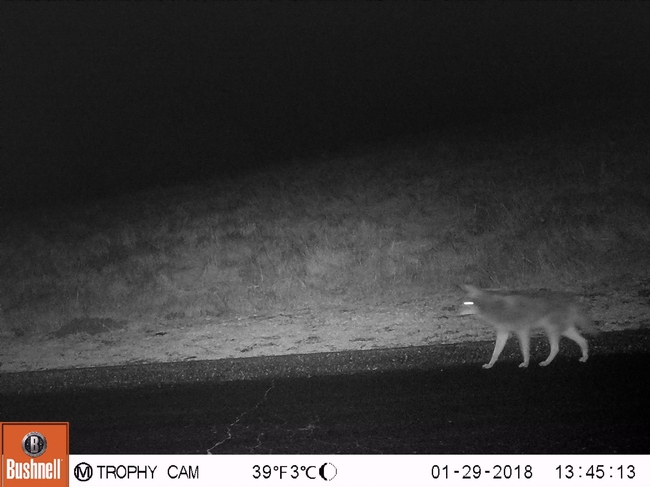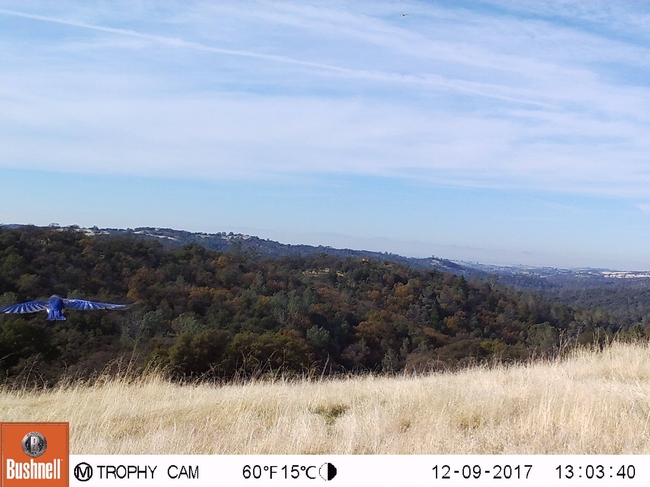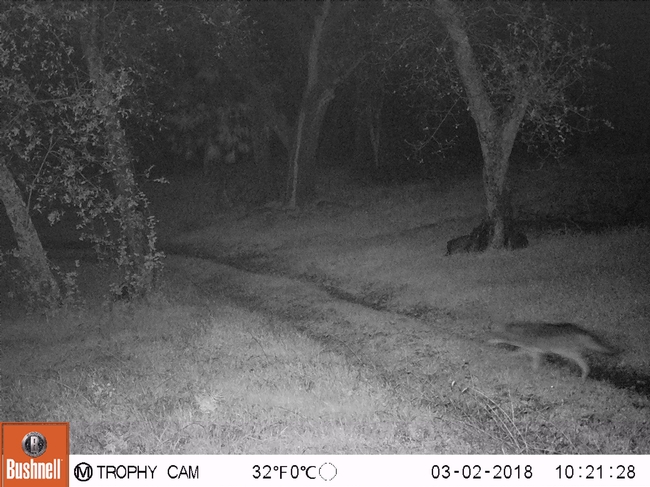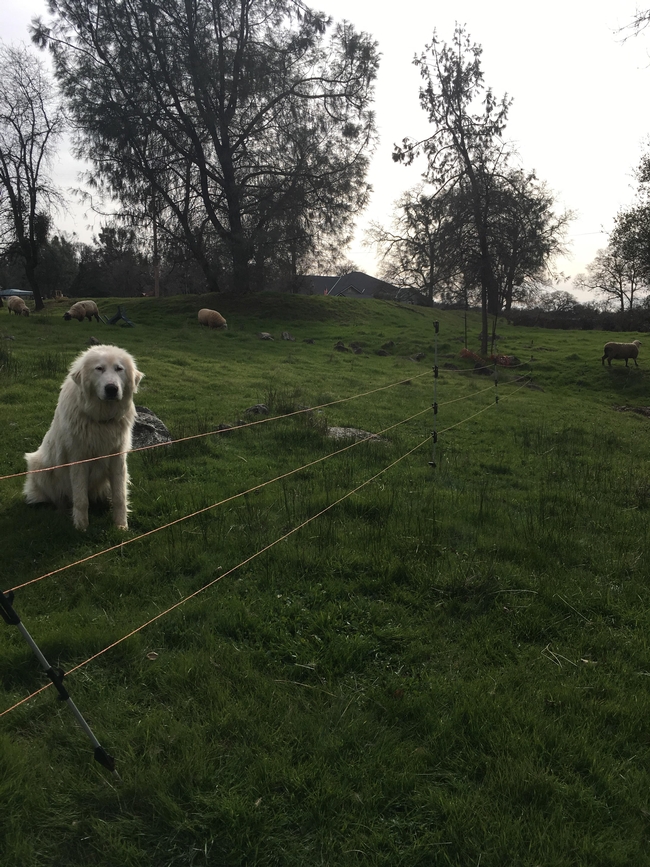- Author: Dan Macon
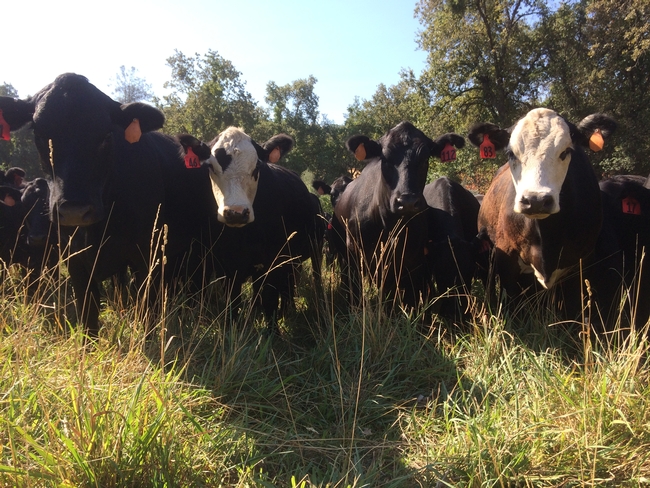
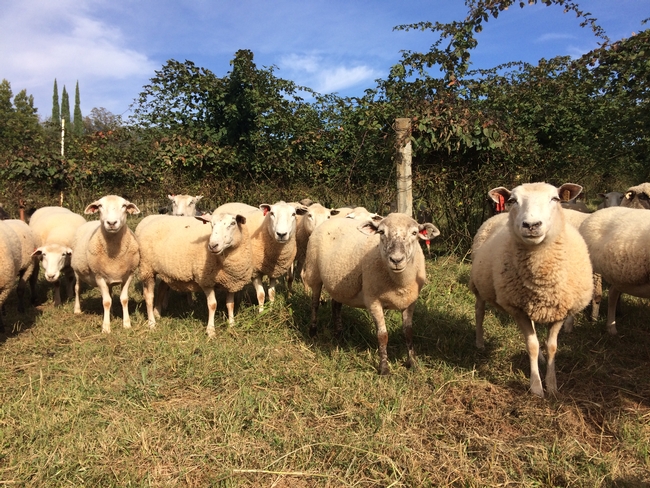
A number of larger ranching operations in the Sacramento Delta have been grazing sheep and cattle together on a large scale with promising results. Typically, a rangeland manager (like me) would suggest that one cow equals five sheep in terms of stocking rate; in other words, for every five sheep a rancher adds to a pasture, he or she would have to remove one cow. The ranchers in the Delta, however, are finding that this ratio doesn't necessarily hold. Ryan Mahoney of Emigh Livestock, for example, reports that he can increase the stocking rate on his pastures by grazing sheep and cattle - without over-utilizing the pastures.
But what about animal performance? Obviously, the point of any commercial grazing operation is to put pounds on livestock or to produce offspring. I recently came across a 2001 paper in Proceedings, Western Section, American Society of Animal Science by B.C. Glidewell (of the USDA Agricultural Research Service in Oklahoma), J.C. Mosely (of Montana State University) and J.W. Walker (of the Texas Agricultural Experiment Station). In an experiment conducted at the U.S. Sheep Experiment Station near Dubois, Idaho, the authors compared the diets and average daily gains (ADG) of yearling Columbia ewes and yearling crossbred steers in four treatments:
- Cattle alone
- Sheep alone
- 75% cattle / 25% sheep
- 50% cattle / 50% sheep
Paddock size varied to keep stocking rate constant between treatments. Fecal samples were used to determine the botanical composition of sheep and cattle diets during the 28-day grazing periods.
Keep in mind that the experiment was conducted on a vastly different range type than the annual rangelands and irrigated pastures in our foothill and Sacramento Valley regions. However, the analysis of dietary preferences suggests more dietary overlap that I would have expected. The diets of both were grass-dominated (see Table 1).
| Livestock | % Grass | % Forbs | % Shrubs |
| Cattle | 80% | 19% | 1% |
| Sheep | 76% | 22% | 2% |
Table 1: Dietary Preferences
When sheep and cattle grazed together, dietary overlap averaged 86%. These findings were consistent with other research conducted on similar forage types in eastern Oregon (Vavra and Sneva 1978), which found dietary overlap of 78-86%. They differed from results in western North Dakota (Kirby et al. 1988), which found 30-35% overlap. The nutritive quality of sheep and cattle diets (as measured by the percent of crude protein (CP) and neutral detergent fiber(NDF)) did vary by treatment. Cattle diets were less fibrous when they grazed with sheep (that is, they were lower in %NDF), likely because cattle ate less grass due to competition with the sheep.
Steer performance (measured in ADG) did not vary significantly among treatments, but did trend higher as the proportion of sheep increased. Similarly, the performance of the yearling ewes in the trial trended higher when sheep grazed with cattle.
The authors also compared total gain per hectare (roughly 2.5 acres). As you might expect, total gain per hectare was related to growing-season precipitation in eastern Idaho. Interestingly, total gain by hectare also seemed to be related to the combination of sheep and cattle. In a wet year, multi-species grazing produced more pounds of livestock per hectare than cattle grazing alone. In a dry year, multi-species grazing produced as much gain per hectare as cattle grazing alone. The authors suggest that over the long term, at least in eastern Idaho, gain per unit of rangeland should increase by grazing cattle and sheep together.
Obviously, multi-species grazing won't fit every operation. Sheep and cattle often require different working facilities, fences, and management skills. However, as ranchers in the Delta are finding anecdotally, grazing cattle and sheep together may actually increase production from a given pasture. We should consider doing a similar study on annual rangelands and irrigated pasture!
Here's the complete reference to the paper:
Glidewell, B.C., J.C. Mosley, and J.W. Walker. 2001. Sheep and cattle response when grazed together on sagebrush-grass rangeland. Proceedings, Western Section, American Society of Animal Science. 52: 156-159.
- Author: Dan Macon
Last week, I held my first California Cattle Grazing School at the UC Sierra Foothill Research and Extension Center in Browns Valley. The two-day school, an adaptation of Roger Ingram's long-running California Grazing Academy, included classroom talks and field-based learning activities. And as I had hoped, it also featured a great deal of rancher-to-rancher learning. Sometimes, I think, many of us learn as much from these informal conversations as we do from prepared lectures - I know I do!
One of the class participants, Clay Daulton, is a long-time Madera County rancher. I've known Clay since I was just starting my professional career more than 25 years ago. Clay recently became a California Naturalist, doing his capstone project for the program on the varieties of grass and forb species on his foothill rangeland. Clay told us, "I spent half of my life paying attention to cattle - I could pick out a sick calf in a pasture from 100 yards away. But I should have been paying attention to my grass." Clay showed us how he calculates the carrying capacity of his ranch each fall based on the weight of the steers he's contracted to graze and on the amount of carryover forage available from the previous spring.
Earlier in the day, after I gave a formal talk about fencing systems and stockwater development, Paidin Gillis, who ranches in Lincoln, shared his technique for keeping water troughs from freezing in colder climates. He sketched out the system on a flip chart while the rest of the class looked on. Clifton Dorrance, from the Hollister area, shared his technique for burying concrete water troughs to keep cattle from undermining the trough - and he told us that this technique also makes water more accessible to wildlife.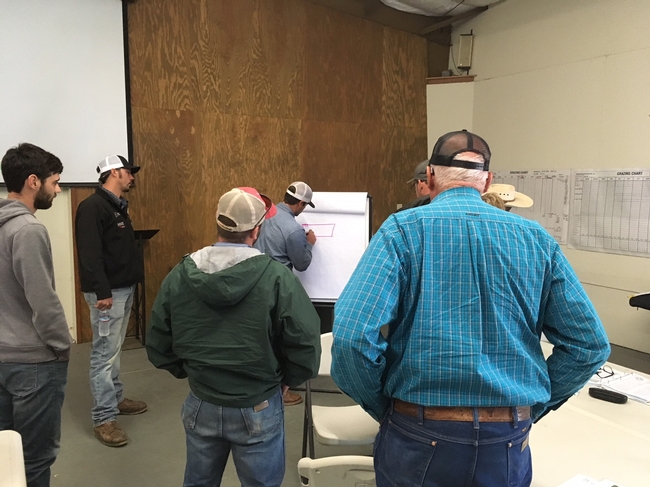
During the first day, a group of local ranchers (known humorously as the "Foothill Grazing Geeks") joined us to talk about how they use the managed grazing principles we cover in the school. Connie Scheiber, from Lincoln, talked about switching their operation from fall calving to spring calving to match forage demand with the period of rapid growth. Joe Fischer, Brad Fowler and Rob Thompson talked about the value of forage diversity in their irrigated pastures. As teachers, Roger and I sat back and listened!
In one of my favorite essays ("Let the Farm Judge", which can be found in Bringing it to the Table: On Farming and Food), Wendell Berry writes,
"What does it mean that an island not much bigger than Kansas [England] ... should have developed sixty or so breeds of sheep? It means that thousands of farmers were paying the most discriminating attention, not only to their sheep, but to the nature of their local landscapes and economies, for a long time."
I was reminded of Berry's emphasis on the knowledge of farmers (and ranchers) this weekend. While much of our work in cooperative extension focuses on research and teaching, I think we serve our communities most effectively when we create space for people to learn from one another, as well.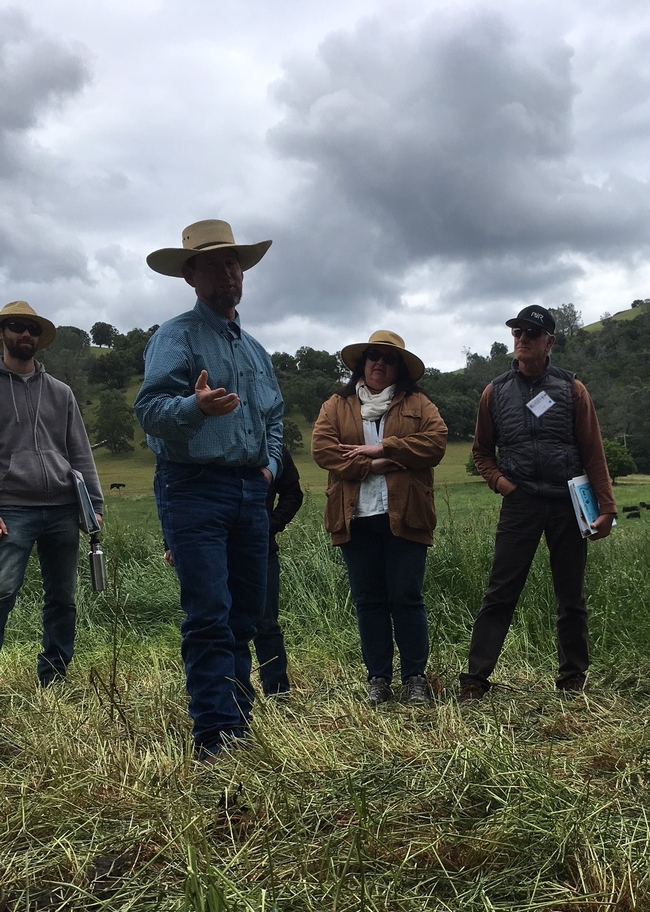
If you missed this year's California Cattle Grazing School, consider registering for our California Sheep and Goat Grazing School in September - stay tuned for details!
- Author: Dan Macon
While it may be difficult to imagine with another atmospheric river storm bearing down on Northern California this evening, irrigation season is just around the corner. Most of the water districts in the foothills will begin delivering water around April 15 - and six months of moving water through irrigated pasture will begin for many of us! Here are a few tips to help make this coming irrigation season run smoothly!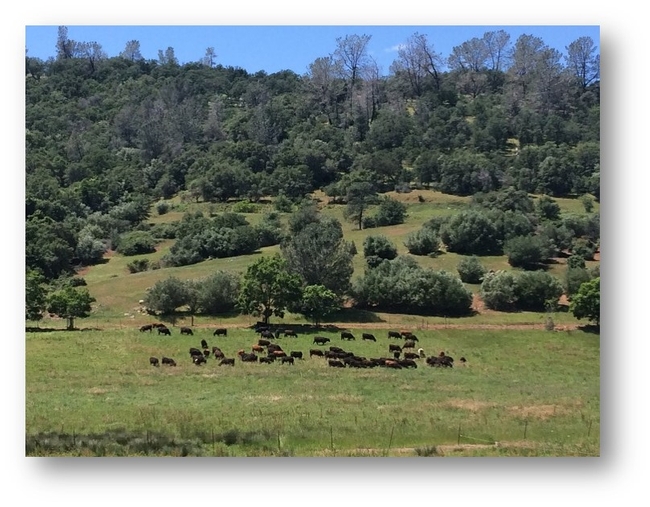
First, we should schedule irrigation (or design our systems) to provide the right amount of water at the right time to meet plant needs. These obviously change as we go through the irrigation season - after this weekend's storm, we should have plenty of soil moisture for a week or more.
Plant and soil water demand, ideally, should determine the quantity of water applied and the frequency of irrigation. This will help improve forage quality, reduce runoff and increase water use efficiency. But how do we know what the plant and soil water demand is?
One of the easiest ways to determine this is simply to learn to assess soil moisture by feel. The Natural Resources Conservation Service has a great pamphlet entitled Estimating Soil Moisture by Feel and Appearance. If you'd rather have a hard copy of the pamphlet (it's even printed on waterproof paper), we have copies at the office!
Another way to determine soil and plant water demand is to use the California Irrigation Management Information System (CIMIS) to estimate evapo-transpiration (or ETo). ETo is the amount of water transpired by plants and lost through evaporation; CIMIS has weather stations throughout the state that provide regional estimates of ETo. The closest stations for our region include one near Auburn and one at the Sierra Foothill Research and Extension Center in Browns Valley. The CIMIS website provides data regarding daily (and even hourly) ETo, precipitation, air temperature, soil temperature, humidity, wind, and a variety of other parameters that can impact irrigation.
Finally, if you'd like to know exactly what's happening in your pastures, I can install a WaterMark moisture sensor. These sensors can help you track the effectiveness of your existing irrigation system and adjust the quantity of water applied and the frequency of application. Call the office if you'd like to schedule an appointment! You can reach me at dmacon@ucanr.edu or (530) 889-7385.
In future weeks, look for additional blog posts about managing irrigated pasture! Also, mark your calendar for Saturday, May 19 - I'll be co-hosting an irrigated pasture workshop with the Nevada Irrigation District and the Nevada County Resource Conservation District in Penn Valley from 8 a.m. - 11:30 a.m. - stay tuned! In the mean time, enjoy the coming rain!
- Author: Dan Macon
April 27-28, 2018
UC Sierra Foothill Research and Extension Center
8279 Scott Forbes Rd., Browns Valley, California
This two-day, hands-on grazing school will provide participants with practical, field-based experience in applying the principles of managed grazing on rangeland and irrigated pasture. Working in teams, participants will learn about grazing planning, paddock design, range ecology, estimating carrying capacity, range ecology and monitoring, and drought planning.
Day 1 (Friday, April 27 - 8:30 a.m. - 7 p.m.)
- Principles of Managed Grazing
- Stocking Rate and Carrying Capacity Field Activity
- Electric Fencing Basics Field Activity
- Practical Grazing Management Field Activity
- Range Ecology and Monitoring
- Feed Budgeting and Drought Planning
Day 2 (Saturday, April 28 - 8:00 a.m. - 4:30 p.m.)
- Nutrition and Supplementation
- Pasture Walk and Assessment
- Beef Cattle Economics 101
- Putting the Principles into Practice - Action Planning for Your Ranch
Cost: $180 (includes meals and course materials). No refunds - your payment guarantees your space!
Hotels are available in Grass Valley and Marysville. Dormitory and camping spaces are available on a first-come-first-served basis at SFREC.
Click Here to Register Online!
For more information:
Dan Macon
(530) 889-7385
dmacon@ucanr.edu
- Author: Dan Macon
Since I haven't posted an update to my Livestock Guardian Dog Journal for four months, I thought an update on this project might be timely! We've been training a new dog to work during lambing (with some interesting observations about behavior). We've trained the new dog to respect 3-wire temporary fencing (as opposed to electro-net). And we've been collecting GPS and trail camera data on predator interactions. Lots to report!
GPS Collaring / Remote Sensing Project
We have been putting GPS sensors on two livestock guardian dogs that are with a flock of 82 sheep (bred ewes and open yearling ewes) west of Auburn. One of these dogs is a 10-year-old Anatolian shepherd neutered male; the other is a 2-year-old Anatolian x Maremma intact male. These collars record location every 5 minutes. We've also deployed seven trail cameras on the parameter of the sheep paddock to document wildlife, domestic animal and human activity in the proximity of the sheep. Our hope is that when we compare the time stamp on photos with the GPS locations of the dogs, we'll begin to understand what kinds of interactions the dogs have with predators and non-predators.
The habitat where the sheep are grazing is foothill oak woodland and open grassland. To date, the cameras have detected coyotes, foxes, deer, jackrabbits, skunks, raccoons, owls, and small birds - along with domestic dogs, walking/jogging/cycling humans and horseback riders. We're in the process of going through the GPS data to determine what the dogs were doing when these animals and people showed up in the cameras. Here are a few of the most interesting photos:
Learning to be a Lambing Dog
Our oldest dog, Reno, has been an outstanding dog at lambing. He keeps his distance from lambing ewes, is very patient with rambunctious lambs, and keeps afterbirth cleaned up (which can attract scavengers and predators). Since he's ten years old, we decided we need to try 2-year-old Bodie with the lambing ewes this year. We also hoped that Reno would teach him manners and respect - Bodie is still a bit immature behaviorally.
Our first lamb was born on February 22, and I was fortunate to arrive shortly after the birth. As has been typical, Reno was lying about 20 yards away from the ewe and lamb. Bodie met me at the pasture fence well away from them. After I had been there about 10 minutes watching the new lamb, Bodie joined us. I shot video of his interaction with the ewe and with Reno - you can view it at this link:
Training a New Lambing Dog (YouTube)
I suspect that some of Reno's protectiveness has to do with his love for eating afterbirth! That said, in the weeks since this interaction, Reno has enforced Bodie's respect for the sheep even when there isn't afterbirth available. And Bodie seems to have matured. He's more respectful of the sheep, less rambuctious in his behavior, and a better guardian dog in general.
Developing an LGD Puppy
Finally, an update on the Pyrenees x Akbash puppy we picked up in September. Elko is going to be a big dog - he's already as big as Bodie. Since pulling the rams from the flock in November, Elko has been with the rams learning manners. For several months, we kept him with Reno (which also helped on the manners front). Since we moved Reno to the lambing flock, Elko has been on his own. He's still definitely a puppy - we're not expecting him to provide much protection at this point, but he is learning to stay with his sheep.
Several weeks ago, we tried an experiment using a different type of fencing. We have found that most of our dogs will stay in 42-inch electro-net. However, we wanted to try training the sheep (and the dogs) to 3-strand poly-wire fencing. I installed a short stretch of fence at our home place and have watched Elko check it out and decide to stay on the proper side. Success!
Here's a relatively recent photo of Elko:
Stay tuned for more information on these topics! And just a note: last week, Reno became lame on a back leg. Our small animal veterinarian thinks he probably tore his ACL. At the moment, he's recuperating in the barn and watching over a trio of very annoying bottle lambs. Given the seriousness of his injury, he's probably permanently retired. He's been a great dog!


